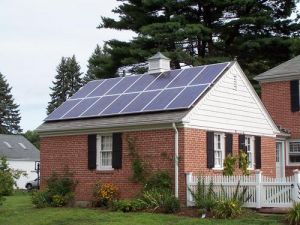A proposal to eliminate part of the harmonized sales tax (HST) from home heating fuels in Ontario is back on the table as of this week. The New Democratic Party of Ontario has set its terms for accepting Ontario’s budget. One of the requests is the removal of the provincial portion of the HST from home heating fuels, a move that could cost the province about $350-million a year in lost revenues.
The request is important because the budget from Ontario’s minority Liberal government needs support from at least one other party. The Progressive Conservatives rejected the budget entirely, handing the balance of power over to the NDP.
The problem with this proposal is simple: it amounts to a subsidy for energy use, which runs counter to Ontario’s goals for conservation and energy efficiency. It builds on the problems of the Liberal government's current Clean Energy Benefit, which already subsidizes higher electricity use with a 10 per cent rebate on electricity bills.
The Clean Energy Benefit was added to dampen the effect of rising electricity prices caused by the cost of replacing aging infrastructure. It artificially lowers the true price of electricity, reducing the incentive to conserve energy. Removing the provincial HST from home heating fuels would further undermine Ontarians’ efforts to save energy.
The dark side of the deal
 We all like the sound of lower home energy bills, but cutting taxes on energy use is not the best way to reduce costs for low- and middle-income households. Removing part of the HST would provide the biggest benefit to the biggest energy users. Economist Stephen Gordon from Laval University estimates that more than half of the roughly $350-million in foregone revenues would benefit the top 40 per cent of income earners, and only a quarter would go to the bottom 40 per cent. In comparison, energy efficiency programs can target lower-income households that are hardest hit by volatile fossil fuel prices, and those least able to afford the up-front costs of retrofits.
We all like the sound of lower home energy bills, but cutting taxes on energy use is not the best way to reduce costs for low- and middle-income households. Removing part of the HST would provide the biggest benefit to the biggest energy users. Economist Stephen Gordon from Laval University estimates that more than half of the roughly $350-million in foregone revenues would benefit the top 40 per cent of income earners, and only a quarter would go to the bottom 40 per cent. In comparison, energy efficiency programs can target lower-income households that are hardest hit by volatile fossil fuel prices, and those least able to afford the up-front costs of retrofits.
The NDP proposal is also shortsighted. If down the road the HST is suddenly added back onto energy bills, or if rising energy costs overtake the savings provided by the subsidy, the homeowners will be back to square one. It would be much more effective to “insulate” our home heating costs permanently with real, installed solutions.
After years of cheap energy, Ontario’s per-person energy use is among the highest in the world. The Ontario Clean Air Alliance’s 2011 Energy Efficiency Strategy points out that our individual energy consumption is 50 per cent higher than New York State’s and double that of the United Kingdom.
But Ontario has lots of room to improve. The Ontario Clean Air Alliance cites a 2009 study for Enbridge Gas Distribution that found residential natural gas use could be reduced by 18 per cent by 2017 in a cost-effective way, meaning the customer would save money over the life of the investment.
A brighter energy deal for Ontario ratepayers
To see long-term, sustained savings on the cost of energy, Ontarians need to start taking energy efficiency and conservation more seriously. Here are a few ways that Ontarians could start lowering energy bills, along with energy demand:
- The provincial government should instruct the Ontario Energy Board to procure all cost-effective energy efficiency options to help the province meet its full potential for energy conservation. Energy efficiency is our cleanest, more affordable energy resource.
- Home retrofit grants and rebates can be effective energy-saving tools. For example, homeowners who conducted retrofits supported by the now-defunct federal EcoEnergy incentive programs expect to reduce their home energy bills, on average, by 23 per cent.
- Innovative financing options allow homeowners to pay for retrofits out of future energy savings, with loans that are transferable from homeowner to homeowner at the time of sale. It’s an idea that’s getting attention in several other jurisdictions.
- Establishing higher energy efficiency standards for new homes and buildings and requiring existing homes and buildings to meet minimum energy performance standards can help make all housing stock more efficient and more affordable.
- Energy efficiency labeling of Ontario homes can help new homebuyers make informed decisions about their future home’s energy bills and carbon footprint.
- Training and certification programs for green-building professionals can help build green retrofitting skills and provide quality control.
The NDP, to its credit, had a strong focus on energy efficiency in its election platform, which included several of the ideas listed above. Other ideas from the NDP platform would have been more effective to put forward, such as offering grants for lower-income homeowners and tenants for home retrofits, and low-interest loans that can be paid back on home hydro bills.
In spite of currently low prices for natural gas, all energy costs are going up, from natural gas to gasoline to electricity. Subsidizing the true costs of energy is not a sustainable solution. To keep household energy costs down in the long term, budget compromises in Ontario ought to be aimed at reducing, rather than subsidizing, energy consumption.









